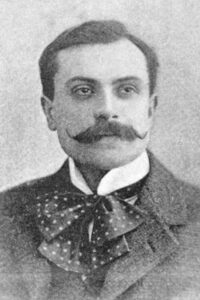
The Mysterious Three
It showed a tall, handsome, clean-shaved man of three or four and thirty, of fine physique, seated astride a chair, his arms folded across the back of the chair as he faced the camera.
“This is the one. Sir Charles,” the butler said, pointing to it.
I distinctly saw Lady Thorold give a start. Sir Charles, tanned though his face was by wind and sun, turned quite pale. Vera, standing by me at the moment, suddenly gripped my arm, I think unconsciously. As I glanced down at her, I noticed her eyes were set upon her mother. They had in them an expression of deep anxiety, almost of terror. Sir Charles was the first to recover his composure.
“Oh—that one,” he exclaimed slowly, with a forced laugh. “Then there is no mystery at all. His giving the name ‘Smithson’ was, of course, his joke. Now we know why he smiled. Thank you, James. You can go.”
I confess that I was puzzled. Indeed, I felt greatly mystified and, to some extent, perturbed. I knew pretty well by my host’s tone and manner. By the look in Lady Thorold’s eyes, perhaps most of all by that squeeze Vera had unconsciously given my arm, all three had received some very unpleasant, apparently some terrible shock. But why? And what could have caused it? Who was that big man whose portrait stood framed there? What was his name? Why had he called himself “Smithson”? What was the mystery concerning him about my hosts, or the mystery relating to my hosts about him? My curiosity was keenly aroused.
I don’t think I am likely ever to forget that date—Wednesday, February 5, 1911—for it marks the beginning of a train of events so remarkable that I would call it unique—only I am not addicted to talking in superlatives. Yet I assure you that I in no way exaggerate and that the story I am about to tell is a record of bare facts.
That February morning was quite bright and balmy. I remember it because it was the first day of the Waterloo Cup meeting. Relatively warm for hunting and at the meet and the coverside, the scraps of conversation one overheard referred chiefly to a big ball at Oakam.
Read or download Book
William Le Queux
William Tufnell Le Queux (2 July 1864 – 13 October 1927) was an Anglo-French journalist and writer.
Biography.
He was also a diplomat (honorary consul for San Marino), a traveler (in Europe, the Balkans, and North Africa), a flying buff who officiated at the first British air meeting at Doncaster in 1909, and a wireless pioneer who broadcast music from his station long before radio was generally available; his claims regarding his abilities and exploits, however, were usually exaggerated. His best-known works are the anti-French and anti-Russian invasion fantasy The Great War in England in 1897 (1894) and the anti-German invasion fantasy The Invasion of 1910 (1906), the latter becoming a bestseller.
Early life
Le Queux was born in London. His father was a French draper’s assistant and his mother was English. He was educated in Europe and studied art under Ignazio (or Ignace) Spiridon in Paris. He carried out a foot tour of Europe as a young man before supporting himself by writing for French newspapers. In the late 1880s, he returned to London where he edited the magazines Gossip and Piccadilly before joining the staff of The Globe as a parliamentary reporter in 1891. In 1893 he abandoned journalism to concentrate on writing and travelling. His partial French ancestry did not prevent him from depicting France and the French as the villains in works of the 1890s, though later he assigned this role to Germany.
Career
Le Queux mainly wrote in the genres of Romance, mystery, thriller, and espionage, particularly in the years leading up to World War I, when his partnership with British publishing magnate Lord Northcliffe led to the serialized publication and intensive publicizing (including actors dressed as German soldiers walking along Regent Street) of pulp-fiction spy stories and invasion literature such as The Invasion of 1910, The Poisoned Bullet, and Spies of the Kaiser. These works were a common phenomenon in pre-World War I Europe, involving fictionalized stories of possible invasion or infiltration by foreign powers; Le Queux’s specialty, much appreciated by Northcliffe, was the German invasion of Britain. He was also the original editor of Lord Northcliffe’s War of the Nations.






